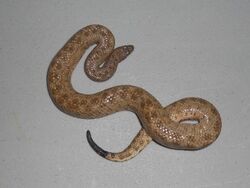Biology:Bahamian pygmy boa constrictor
| Bahamian pygmy boa constrictor | |
|---|---|

| |
| Scientific classification | |
| Domain: | Eukaryota |
| Kingdom: | Animalia |
| Phylum: | Chordata |
| Class: | Reptilia |
| Order: | Squamata |
| Suborder: | Serpentes |
| Family: | Tropidophiidae |
| Genus: | Tropidophis |
| Species: | T. canus
|
| Binomial name | |
| Tropidophis canus (Cope, 1868)
| |
| Synonyms[1] | |
| |
The Bahamian pygmy boa constrictor (Tropidophis canus), also known as the Inagua trope or Bahama wood snake, is a species of nonvenomous snake in the family Tropidophiidae. The species is endemic to Great Inagua Island in the Bahamas.[2][1][3]
Description
Like all species of pygmy boas the Bahamian pygmy boa is a rather small snake averaging between 30 cm (12 in) and 60 cm (24 in) in total length.[3][4] The snake has the ability to change color through the movement of its dark pigment granules. Depending on the time of the day, a light or dark color may provide better camouflage.[3] The Bahamian pygmy boa has a yellow-orange tail tip, which is likely used to lure unsuspecting prey.[3]
Behavior
The Bahamian pygmy boa is mostly inactive during daytime hours, usually coming out at night.[3] Most dwarf boas are terrestrial, meaning they live and breathe on earth, and rest underground or in vegetation. A few have adapted to being arboreal.[3][4] Young boas live in trees and shrubs and feed mostly on anole lizards. Adult boas feed on frogs, birds and rats.[5] If threatened, the snake has been observed to coil up into a tight ball similar to that of a ball python.[3] On Andros Island the species is known as the "shame snake" because of this defensive tactic.[3] It also has the ability to voluntarily bleed from its eyes, mouth, and nostrils.[3][4]
References
- ↑ 1.0 1.1 Tropidophis canus at the Reptarium.cz Reptile Database. Accessed 10 February 2021.
- ↑ Cite error: Invalid
<ref>tag; no text was provided for refs namediucn status 20 November 2021 - ↑ 3.0 3.1 3.2 3.3 3.4 3.5 3.6 3.7 3.8 "Snakes". Ardastra Zoological Gardens. http://www.ardastra.com/snakeinfo.html#boa.
- ↑ 4.0 4.1 4.2 Schwartz, Albert; Henderson, Robert W. (1991). Amphibians and Reptiles of the West Indies: Descriptions, Distributions, and Natural History. Gainesville: University of Florida Press. 720 pp. ISBN 0-8130-1049-7. https://books.google.com/books?id=0x_hxEolYUAC&dq=Tropidophis+canus&pg=PA632.
- ↑ "Bahamian Boa Constrictor". https://bnt.bs/wildlife/reptiles/snakes/bahamian-boa-constrictor/.
Further reading
- Bailey JR (1937). "A review of some recent Tropidophis material". Proc. New England Zool. Club 16: 41-52. (Tropidophis pardalis barbouri, new subspecies, p. 49).
- Boulenger GA (1893). Catalogue of the Snakes in the British Museum (Natural History). Volume I., Containing the Families ... Boidæ ... London: Trustees of the British Museum (Natural History). (Taylor and Francis, printers). xiii + 448 pp. + Plates I-XXVIII. (Ungalia cana, p. 114).
- Cope ED (1868). "An examination of the REPTILIA and BATRACHIA obtained by the Orton Expedition to Equador [sic] and the Upper Amazon, with notes on other Species". Proc. Acad. Nat. Sci. Philadelphia 20: 96-140. (Ungalia cana, new species, p. 129).
- Garman S (1887). "On West Indian Reptiles in the Museum of Comparative Zoölogy, at Cambridge, Mass." Proc. American Philosoph. Soc. 24: 278-286. (Ungualia curta, new species, p. 279).
- Schwartz A, Thomas R (1975). A Check-list of West Indian Amphibians and Reptiles. Carnegie Museum of Natural History Special Publication No. 1. Pittsburgh, Pennsylvania: Carnegie Museum of Natural History. 216 pp. (Tropidophis canus, pp. 191–192).
- Stull OG (1928). "A Revision of the Genus Tropidophis ". Occ. Pap. Mus. Zool. Univ. Michigan (195): 1-52. (Tropidophis pardalis androsi, new subspecies, pp. 34–35).
External links
Wikidata ☰ Q2384667 entry
 |


